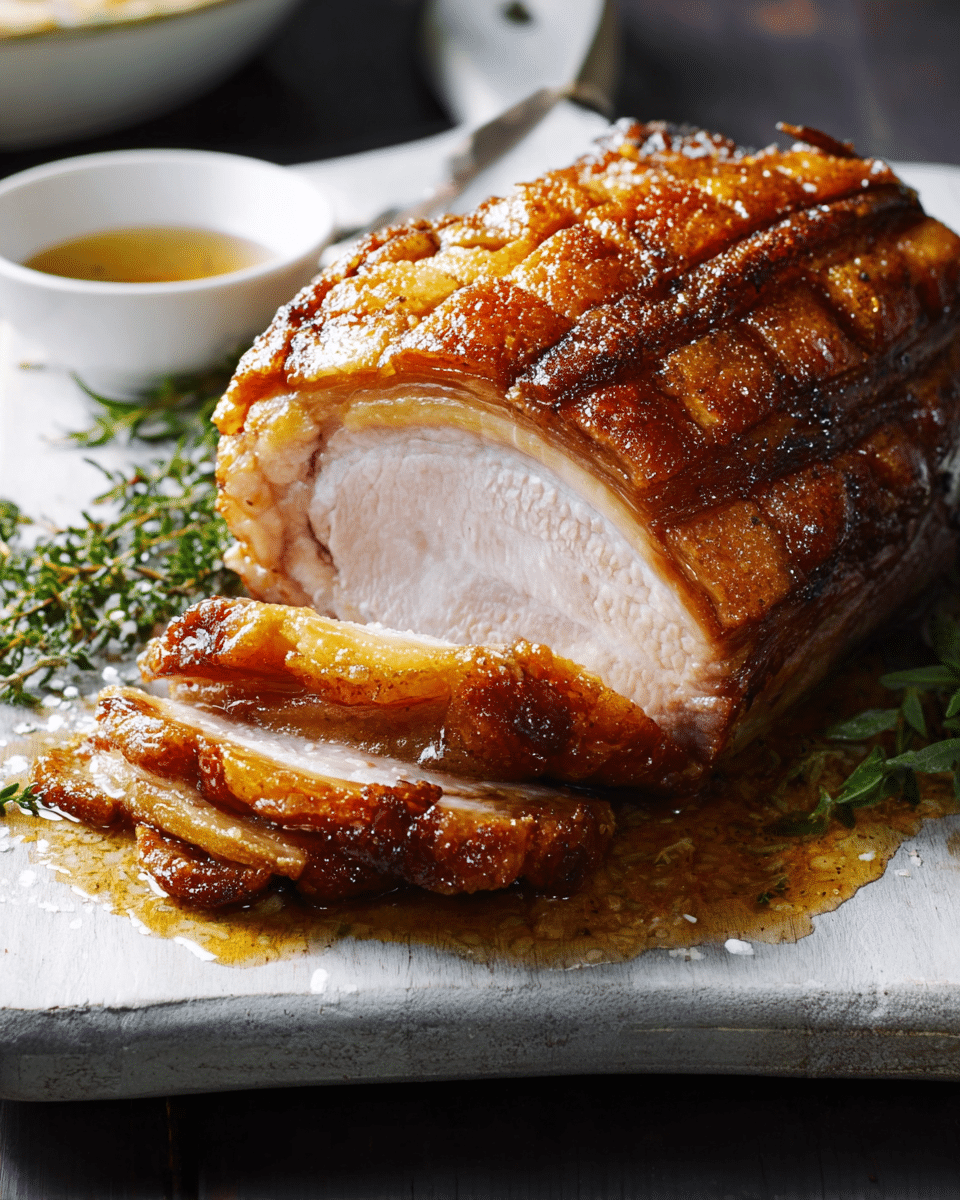This Roast Pork with No-Fail Crackling features beautifully crispy skin paired with tender, juicy meat. The perfect balance of herbs, fennel, and coriander elevates the savory flavors, making each bite melt in your mouth.
Ideal for holiday feasts or a comforting Sunday dinner, this roast pork recipe guarantees crispy crackling every time. Its golden, crisp exterior contrasts perfectly with the moist and tender interior. Serve alongside your favorite roast vegetables or a rich gravy for an unforgettable meal.
Full Recipe:
-
1.8–2kg bone-in pork belly, skin scored
-
2 tablespoons sea salt
-
1 tablespoon olive oil
-
1 teaspoon fennel seeds
-
1 tablespoon ground coriander
-
1 teaspoon cracked black pepper
-
2 cups water
-
2 large onions, quartered
-
4 garlic cloves, smashed
-
2 sprigs rosemary
Directions:
-
Preheat the oven to 230°C (450°F).
-
Pat the pork skin dry with paper towels. Rub the skin with olive oil, sea salt, fennel seeds, coriander, and cracked black pepper. Ensure the skin is well-seasoned and that the rub gets into the scored lines.
-
Place the pork belly on a rack in a roasting pan. Add the onions, garlic, and rosemary around the pork. Pour the water into the pan, ensuring it doesn’t touch the pork skin.
-
Roast for 30 minutes, then reduce the oven temperature to 180°C (350°F) and continue roasting for 1.5-2 hours, or until the crackling is golden and crispy, and the meat is tender.
-
Remove the pork from the oven and let it rest for 10 minutes before slicing. Serve with your favorite sides.
Prep Time: 10 minutes | Cooking Time: 2 hours | Total Time: 2 hours 10 minutes
Kcal: 350 kcal | Servings: 6 servings
History and Origin
Roast pork is one of those classic dishes that has stood the test of time across various cultures and cuisines. Its roots can be traced back to ancient times when pigs were domesticated for their versatility and hearty meat. The tradition of roasting pork, especially with the crispy skin or “crackling,” dates back centuries, and its popularity surged in many European cultures, particularly in Germany, the UK, and Scandinavia.
In these regions, roasting a pig or a pork cut over an open flame or in an oven became a celebratory dish, often reserved for special occasions and large family gatherings. The idea of crackling—crispy pork skin—originated from a need to preserve the meat and enhance flavor. Slowly roasted in high heat, the skin crisps up, forming a crunchy contrast to the rich, moist meat beneath. This method became not only a way to cook but a culinary tradition that was passed down through generations.
While roast pork with crackling is common in many Western and European cuisines, it also has a presence in various Asian countries, where different methods and flavors are used. The Chinese, for example, are famous for their “siew yuk” (roast pork belly), which also features crispy skin and tender meat.
This no-fail crackling roast pork recipe has its origins in these time-honored traditions, providing a modern twist by ensuring that the crackling is foolproof every single time. Curtis Stone, the renowned chef, popularized this method of making crackling crispy and delicious, removing the guesswork and ensuring home cooks can achieve perfection.
Variations and Adaptations
One of the best things about roast pork is how adaptable it is to various flavors and cooking methods. While the classic approach remains beloved by many, there are plenty of regional and cultural variations that give this dish new life.
-
Herb Variations: In Mediterranean regions, herbs like rosemary, thyme, and garlic are often incorporated into the rub or stuffed into the pork belly to infuse it with aromatic flavors. This variation is particularly popular in Italy, where roasted meats are often accompanied by fresh herbs.
-
Asian Influence: In Asian countries, such as China and Taiwan, roast pork often features five-spice powder, soy sauce, hoisin sauce, and sometimes a hint of sugar, giving the meat a sweet-savory balance. The crackling is still essential, but the flavor profile is distinctly different due to the spices.
-
Apple and Sage: In some parts of the UK and Ireland, apples and sage are used to stuff the pork belly, adding a sweet and savory element to the meat. Roasting the pork alongside apples gives the dish a slight fruitiness that pairs perfectly with the rich pork flavor.
-
Spicy Pork: For those who enjoy a bit of heat, chili flakes or cayenne pepper can be added to the seasoning rub. This variation is often seen in Southern cooking or in more adventurous takes on the classic roast.
-
Crispy Crackling: The method of achieving crispy crackling is incredibly important. While traditional methods often require the skin to be scored deeply, some recipes suggest dry brining the pork belly overnight to help render the fat and ensure the skin crisps perfectly. The key is to start with a high oven temperature and then reduce it to cook the meat through without burning the skin.
Nutritional Information
While roast pork with crackling is undeniably delicious, it’s also important to consider its nutritional profile, especially when served as a hearty main course.
A typical serving of roast pork belly with crackling (about 100 grams) provides roughly 350 kcal, with a significant portion coming from fat due to the pork’s marbling and the rendered fat. Here’s a closer look at the macronutrients:
-
Protein: Pork is a good source of lean protein, which is essential for building and repairing tissues in the body. A 100-gram serving of pork provides approximately 25-30 grams of protein.
-
Fat: Pork belly is high in fat, particularly saturated fat. A typical serving can contain 20-25 grams of fat, with about 8-10 grams being saturated fat. While fat is necessary for the body, it’s important to enjoy this dish in moderation, particularly if you’re watching your cholesterol levels.
-
Carbohydrates: Pork itself contains minimal carbohydrates, making this dish suitable for low-carb and ketogenic diets. However, when paired with starchy side dishes like potatoes or rice, the overall carb content of the meal will increase.
-
Vitamins and Minerals: Pork is a good source of essential vitamins and minerals, particularly B vitamins like niacin (B3), thiamine (B1), and riboflavin (B2). It also provides important minerals like selenium, zinc, and phosphorus, which support immune function, metabolism, and bone health.
While this dish is higher in fat, the nutrients found in pork can contribute to a balanced diet when eaten in moderation.
Serving Suggestions and Pairings
Roast pork with crackling is a versatile dish that pairs beautifully with a variety of sides and drinks. Here are some serving ideas to elevate your meal:
-
Classic Pairings: Roast vegetables such as carrots, parsnips, and Brussels sprouts complement the rich flavors of the pork. For a truly comforting experience, serve the pork with mashed potatoes or roast potatoes, which soak up the delicious juices from the meat.
-
Sauces: A rich apple sauce or tangy mustard sauce can cut through the richness of the pork and add a burst of flavor. For a more decadent twist, you can also serve it with a creamy gravy or a sweet, tangy cranberry chutney.
-
Greens: A side of sautéed greens like spinach, kale, or green beans offers a lighter, healthier contrast to the heavy, rich pork. The slight bitterness of the greens balances the savory taste of the roast.
-
Breads: Crusty bread or Yorkshire puddings are traditional accompaniments, especially in British-style roasts. These help to mop up the flavorful juices from the meat.
-
Drinks: A robust red wine, such as a Shiraz or Cabernet Sauvignon, pairs wonderfully with roast pork, especially when served with rich sides. If you prefer beer, a malty ale or lager works well to complement the roasted flavors. For non-alcoholic options, apple cider or a refreshing lemon spritz would be a great choice.
Tips and Tricks for Success
To ensure your roast pork turns out perfectly every time, here are some expert tips to help:
-
Dry the skin thoroughly: The key to perfect crackling is ensuring the skin is as dry as possible before roasting. Use paper towels to pat the skin dry and leave it uncovered in the fridge for a few hours or overnight to further dry out the skin.
-
Score the skin evenly: If your pork belly isn’t pre-scored, be sure to score the skin in a crisscross pattern with a sharp knife. This allows the fat to render and the skin to crisp up properly.
-
Use high heat at the beginning: Start by roasting the pork at a high temperature (230°C or 450°F) to get the crackling nice and crispy. After about 30 minutes, reduce the heat to cook the pork through without burning the skin.
-
Let it rest: Allow the roast pork to rest for 10-15 minutes after removing it from the oven. This helps the juices redistribute throughout the meat, ensuring it remains tender and moist.
Potential Health Benefits
While roast pork with crackling isn’t the lightest meal, it does offer some nutritional benefits. The protein in pork helps to support muscle growth and repair, making it a good option for those looking to maintain or build muscle mass. The B vitamins found in pork, particularly niacin and thiamine, are essential for energy production and maintaining healthy metabolism.
Advertisement
The addition of herbs like rosemary and garlic provides antioxidants, which help combat oxidative stress in the body. Additionally, rosemary has been linked to improved digestion, while garlic is known for its immune-boosting properties.
Conclusion
Whether it’s for a holiday feast or a simple family dinner, this no-fail crackling roast pork recipe is a guaranteed winner. Its combination of juicy, tender meat and perfectly crispy skin makes it a showstopper at any table. With a variety of serving suggestions and an easy method that ensures success, this dish is as delicious as it is satisfying. Give it a try and experience the flavors and textures that have made this classic roast pork a timeless favorite!





